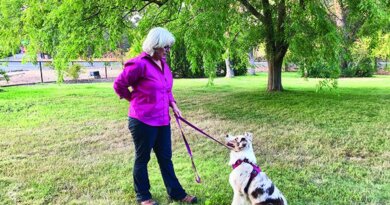10 Best Tips to Reunite You With Your Dog
It’s a terrifying feeling to realize that your dog may have ran away and gotten lost, or worse – was stolen. Ideally, you’ve microchipped your pet, placed an ID tag on the dog’s collar and maybe even used a GPS tracker or GPS collar. If not, below are some tips on how to find a missing dog and what you should do as soon as possible.
1. Use a Scent Article
This is the best advice on finding missing dogs that hunters have been using for centuries on finding their own lost canines. Pair this advice with the rest of the tips listed below.
Dogs have an outstanding sense of smell: not only can they smell from far away, but their brain is also wired in a way where scent provides the dog with various information. Not only that, but studies have shown that dogs have their favorite scent – their owner – which means they will prioritize your smell over anything else.
To utilize this to your advantage, pick a scent article, which can be a piece of your (dog owner’s) clothing that you’ve worn for a while – the longer, the better. Take this scent article to whatever the location the dog was last seen or where you think your dog escaped from. You can also bring your dog’s crate, toys, blanket, etc.
Leave the scent article in that location, and come back later in the day, or the next day. Keep coming back to that location every 6 to 12 hours. Ideally, your dog will eventually be waiting for you in that spot, resting on your piece of clothing at some point. Many owners have found their missing dogs this way.
Note: You can also leave a bowl of water with the scent article(s) but do not leave any food so as not to attract any other animals. Also, you can pick several locations and do the same in multiple spots, then keep checking them. Finally, consider leaving a note (especially if you leave a dog crate there) for anybody who comes across these things.
2. Whistling and Calling
While some escaped dogs might be roaming around the neighborhood, consider the fact that your pup might have gotten himself trapped somewhere. Maybe the dog’s collar got caught on something, or the dog accidentally got stuck behind a fence. Your pooch may be somewhere nearby but simply cannot get back home.
Whistling and calling the dog’s name while walking around the neighborhood seems obvious but for whatever reason, many owners forget to try this. So give it a shot, and see if your pooch responds to your call with his own bark. After a bit of Marco-Polo playing, you may just find your missing dog waiting to be saved by you somewhere.
Here’s an example story from a Reddit forum:
3. Check Dog Tag GPS
An obvious action on how to find a missing dog – if you took precautionary measures and equipped your pet with a dog GPS collar or a simple GPS tag locator – is to check and find your dog’s location. Even some simple fitness/activity trackers might have a GPS locator that you didn’t know about, so check if yours might have had that option.
Here’s what a pet GPS tracker will look like on your phone:
These nifty safety accessories often cost a monthly subscription in addition to the initial price of the device but can accurately tell you not only where your pooch has run off to but also keep track of their activity by monitoring their heart rate. However, not every pet owner has these helpful commodities, in which case, extra steps need to be taken.
4. Keep Your Phone Close
No matter the circumstances, the first thing many people will do when they find a lost dog is check that pet’s collar for tags and check the tags for information on how to contact an owner. Many dog ID tags allow owners to list more than one phone number, which can increase your chances of connecting with a kind citizen who has found your pet.
When you put an ID tag on your pooch, you may also want to list your cell phone and land line, or your number as well as a family-member’s. When your dog is missing, be sure your phone is always on ringer, that way you get the phone call as soon as any new developments occur.
5. Do Some Research
Revisit the area where your dog escaped and ran off, and search nearby as well. A little detective work of your own can go a long way in finding a missing dog. Ask neighbors if they heard or saw anything. Nearby loud construction or fireworks could cause a terrified animal to escape that area and hide somewhere where it’s quieter.
Did your dog happen to leave anything behind? Any information you discover will define the next steps you need to take. For example, perhaps when your pup dug and squeezed themselves under the backyard fence, their collar snapped off. In this case, you’ll at least know that no one will be able to contact you.
You can also deduce that anyone who happens to see your dog without a collar will assume it is a stray and they may call animal control, which would lead you to the next step you should take: calling local shelters.
6. Ask and Notify Local Shelters
The crucial step to find a missing dog is to contact organizations that deal with this on a daily basis. Most people who see a dog running lose will call animal control and when the dog doesn’t have any form of identification (microchip or tags), then they’re likely to be taken to the local animal shelter.
Call all animal shelters that are closest in proximity to where your dog got lost and explain the situation. They’re likely to ask if the dog has identification; if not, they’ll ask for a few descriptors of your animal.
Provide the shelter with the dog’s photo via email, and some helpful characteristics such as your dog’s age, general size and weight, hair color and length, as well as any unique traits, such as odd coat markings or scars.
7. Notify Others
No matter where you live, neighbors are a powerful resource in potentially helping you find your lost companion and even give you more helpful tips and information on how to find a missing dog.
In a rural area, where your neighbors aren’t easily available next door, post a missing dog flyer (see our two missing dog flyer samples below) at a heavily-trafficked businesses, such as a popular local eatery, post office, or grocery store. Many of these commercial buildings will have a community board you are free to use, but if not, you can politely ask the staff if you can utilize their window space.
A simple missing dog flyer sample (full size here):

More detailed missing dog flyer sample (full size here):

Use a simple missing dog flyer to post around the neighborhood, and use a more detail flyer to post in very specific places or give out to your friends and neighbors, or to some locations like post office and stores where you think your missing dog might end up.
If your dog is friendly and trusting of strangers, you can even leave a small bag of their favorite treats with your neighbors and request their help in baiting the dog if they happen to see your pet in the region. Leave your cell phone number with them just in case they successfully locate your pet.
Of course, should knocking door-to-door or making and printing out missing dog flyers require too much of your time during a busy workweek, there’s another resource: the Internet.
8. Social Media Outreach
Perhaps the most efficient way to get the word spread about a missing animal is social media, and there’s been tons of cases where social media was crucial in locating missing dogs. Other websites can also be very helpful, so do some research online.
Before you go through social media, you can also visit sites like Pet FBI that are designed specifically to help with finding missing dogs and reuniting owners with lost pets.
Facebook has a “Marketplace” tab where anyone can post items for sale. The “Share” button will help your online friends share the post with their friends and on and on, creating a domino effect. There are Facebook Groups dedicated to sharing photos of lost dogs. You can find these through a general Google search or through Facebook itself.
Here are some Facebook groups for missing dogs that you can utilize:
You can also try using Reddit, which in some cases will be more popular (and more helpful) than Facebook. Simply publish a “Missing Dog” post in your city’s subreddit. For example, if you live in Austin, TX then you can go to /r/Austin and ask people’s help (include a photo). Here’s an example of a person looking for a lost dog on that subreddit (and an update of a successful resolution).
Now, consider this advice when sharing a post on social media about your lost dog – this is how you can ensure the most shares and have most success:
Keep the text of the post short and sweet. The average online user may become easily discouraged to read a lengthy post and scroll right past it. What you absolutely should include: the dog’s name, a short description of their appearance and temperament, and when and where they went missing.
Consider the photo of your dog. You should use a recent photograph of your dog. While their picture as a puppy is adorable, it won’t be an accurate representation of their current appearance and online viewers are most likely to remember the photo, not the written description accompanying it. Also take into account the coloring of the photo: odd lighting can make colors distorted, giving brown fur a black color or red fur a blonde hue. Try to include two photos if you can, one of their face as well as a full-body one to give an idea of their size. Don’t add more than four pics.
Make the post public. In order to make sure your post is shareable, it should be adjusted as a “Public” post. This is selected by clicking on the small icon directly under your name that looks like the silhouette of two people. Click this icon and select “Public” which will have a small icon depicting Earth. Making the post public will give you better outreach and improves your chances of reuniting with your missing dog.
Don’t include your personal information. Since this post will be viewable by anyone on the Internet, you may want to be cautious about including your phone number. Instead, request that Facebook users send you a message. This will keep you safe from scammers and prank phone calls.
Regularly check your Facebook messages. If someone you aren’t friends with on Facebook sees your post and has valuable information, they will attempt to message you. However, if you aren’t friends, their message will go into your inbox as a “Message Request” without any notification to you. At the top of your message inbox are two tabs, one says “Recent” and the other says “Message Requests” which is where you will find messages from anyone you are not friends with. You can then decide to accept or decline these communication requests.
These social media lessons might seem obvious or unnecessary to some, but when it comes to how to find a missing dog, any little helps in increasing your chances of reunion.
9. Consider Your Dog’s Favorite Places
There are numerous reasons as to why our faithful hounds may run away, but sometimes it doesn’t take too much guess work. Dogs have a favorite “hang out”. Maybe it’s the dog park you frequent together on the weekends or maybe it’s a house a few blocks away that has a doggy playmate they’re anxious to visit.
Either way, one of your pet’s favorite spots could be the destination they’ve escaped to. If you have no other means to locate your missing dog, one of the first things you can do is look for them, starting with their favorite places and doing more Sherlock Holmes-like detective work.
10. Browse Online “Shops”
Sadly, some dogs go missing because they’re stolen right from their backyard. The biggest motivation to these crimes is often profit related. So begin regularly checking online marketplaces, such as Craigslist, as thieves may utilize these sites. In many countries, dog stealing is actually on the rise right now. In cities where this is particularly common, search queries for how to find a missing dog are increasing as well.
“Dog-flippers” will often attempt to cover their tracks by dyeing a dog’s hair a different color, so if you have suspicion that photos of a dog online look strikingly like yours, follow through by posing as a buyer. If your lost pet is microchipped, you can bring along a microchip reader to confirm if it is your dog or not.
Universal microchip readers like this are good but they can be pricey. Some microchips will come with their own specific reader that you can use instead. If your dog is a rescue, you can coordinate with the animal shelter and request their help by accompanying you to meet with the thief/seller.
If you have reasons to believe your pet has been stolen, you can file a report with the police. This will be especially beneficial to you if you do find your previously lost dog online for sale. Remember: pets are considered valuable property which means by criminal law theft is a misdemeanor, in some cases, a felony.
How to Prevent Your Dog Going Missing
Prevention is the best cure, they say. So to avoid having you go through the process of how to find a missing dog in the future, here’s how to prevent this from occurring:
Stay Updated
Consider using a GPS tracker, and always microchip your dog and use ID tags. Then, remember to update your dog’s collar and microchip information every time any of your contact information changes. Most microchip’s information can be updated online in a matter of minutes and purchasing a new tag is just as simple when you visit your nearest pet supply store or adoption center.
Ensure Security
If your dog is frequently getting out of the house or yard, revisit the area they are escaping from. Routine maintenance, such as replacing rotting wood, can better ensure your dog is secure. If your dog is good at jumping over fences, there are things you can do to prevent this.
Communicate with others in your household, if any, about the importance of keeping doors and windows closed. Some owners are against it, but others may utilize an invisible dog fence to prevent dogs being easily distracted by other animals and running away from the backyard, then getting lost.
Invest in Toys
If your dog is frequently getting lose, it could be that they’re extremely bored and lonely while you’re not home. It may sound simple but purchasing some time-consuming chew toys, particularly interactive dog toys or other mechanisms designed with dogs in mind could lessen their desire to run away.
There are a number of brands that cater to a dog’s want to not only chew but to also problem-solve. These interactive dog toys are like puzzles and may keep a food-motivated canine entertained for hours. Not only will they be less depressed, they’ll also be less likely to think about how to get out of the house or yard and you won’t have to then go looking for tips on how to find a dog missing if that happens.
Make Your Dog Known
If you live in a smaller town with a friendly neighborhood where others also have dogs, you can all work similarly to how Neighborhood Watch works. Create a doggy business card, complete with photo of your beloved pet and your cell phone or work number. Share this with your neighbors (and encourage them to share theirs with you).
This will help them identify your dog should they ever become lost again and may be able to help detain them or at least contact you to let you know where they were last seen.
If your dog hasn’t gone missing yet, I highly recommend going through these steps of prevention to ensure that you never need to visit an article on how to find a missing dog after the fact.
READ NEXT: Lost Dog – How to Cope With Every Dog Owner’s Worst Nightmare







